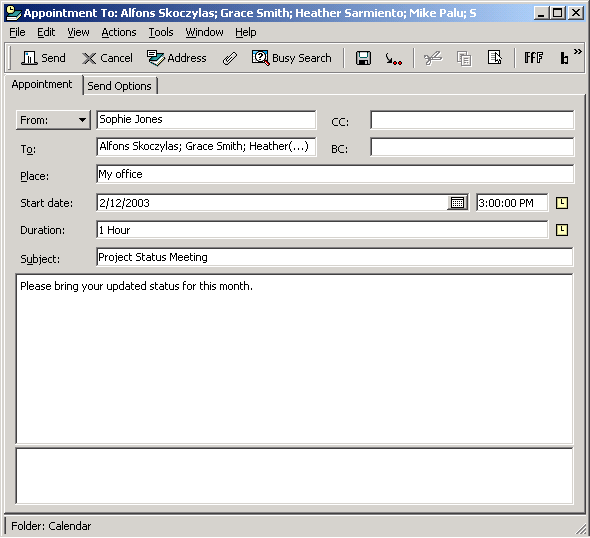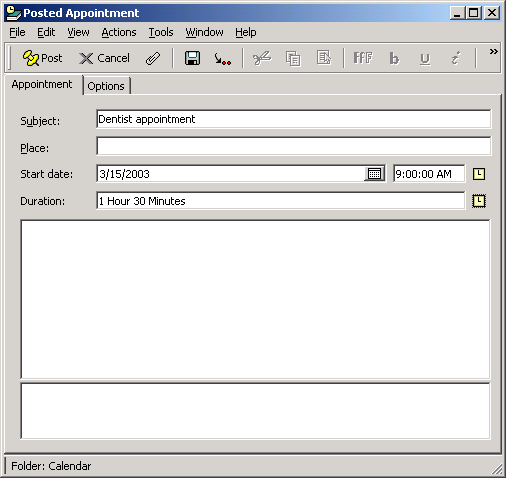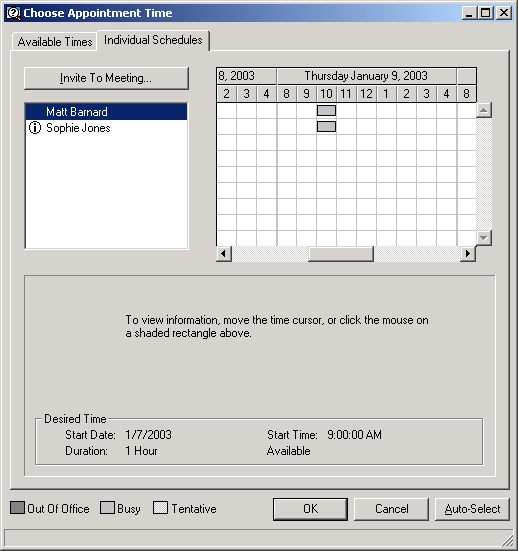Scheduling Appointments
Use appointments to schedule blocks of time on a specific date or range of dates.
You can use Busy Search to check for a time when all the users and resources you want for an appointment are available.
This section contains the following topics:
- Scheduling an Appointment for Other Users
- Rescheduling an Appointment
- Rescheduling Recurring Appointments
- Canceling an Appointment
- Scheduling an Appointment for Yourself
- Checking When Everyone Is Available
- Formatting Your Appointments in ICAL
Scheduling an Appointment for Other Users
-
Click
 on the toolbar.
on the toolbar. -
In the To box, type a username, then press Enter. Repeat for additional users. In addition, include any resource IDs (such as conference rooms) in the To box. If necessary, type usernames in the CC and BC boxes.
or
To select usernames or resources from a list, click Address on the toolbar, double-click each user, then click OK.
-
To change the From name (to another account or proxy), click
 , then click a name.
, then click a name. -
Type the place description in the Place box.
-
Specify the start date.
or
Click
 to specify a date or auto-date for your appointment.
to specify a date or auto-date for your appointment. -
Specify a start time and duration. Duration can be in minutes, hours, or days.
-
Type a subject and message.
If you want, change the font of the message text. For information, see Changing the Font of Items You Send.

-
If you want to make sure the people and resources for the appointment are available, you can do a busy search by clicking Busy Search on the toolbar. See Checking When Everyone Is Available.
If you want to perform a busy search on users in a POP3 or IMAP4 account that supports the CAP protocol, you must first add a CAP account on the CAP tab in the Accounts dialog box. For information, see Adding a CAP Account to GroupWise (v6.5 for NNLS 1.0). You do not need to add a CAP account if you are searching on users in a GroupWise system.
You can specify many options, such as making this appointment a high priority, requesting a reply from recipients, and more, by clicking the Send Options tab.
-
Click Send on the toolbar.
Rescheduling an Appointment
If you want to make sure the people and resources for the appointment are available, you can do a busy search by clicking Busy Search on the toolbar.
-
Click the Sent Items folder in the Folder List.
-
Click the appointment to reschedule.
-
Click Actions, then click Resend.
-
If the original appointment was an auto-date appointment, click This Instance or All Instances.
-
Make your changes, then click Send on the toolbar.
-
Click Yes to retract the original item.
To reschedule an appointment for a new time on the same day, open your Calendar and drag the appointment to the new time.
Rescheduling Recurring Appointments
-
Click the Sent Items folder in the Folder List.
-
Click the appointment you want to select.
If you are rescheduling just one appointment in a series of recurring appointments, select the appointment on the day you want to reschedule.
-
Click Actions, then click Resend.
-
Click All Instances for all appointments in the recurring appointment.
or
Click This Instance for only one appointment in the series of recurring appointments.
-
Make your changes, then click Send on the toolbar.
-
Click Yes to retract the original item.
To reschedule an appointment for a new time on the same day, open your Calendar and drag the appointment to the new time.
Canceling an Appointment
You can cancel an appointment if you scheduled it or if you have the necessary Proxy rights to the scheduler's Mailbox.
Scheduling an Appointment for Yourself
If you are not available for meetings, schedule a posted appointment for those times. When another user includes you in an appointment and does a busy search, the user can see you are not available at those times, but can still schedule over your appointment.
Posted appointments are placed in your Calendar on the date you specify. They are not placed in your Mailbox or in any other user's Mailbox.
-
On the toolbar, click the arrow on the
 button, then click Posted Appointment.
button, then click Posted Appointment.
or
In your Calendar, open a view with an Appointments List, click a date, then double-click a time in the Appointments List.
-
Type a subject and a place (optional).
-
Specify the start date and start time if you haven't already done so.
-
If necessary, click
 to specify a date or auto-date for your appointment.
to specify a date or auto-date for your appointment. -
Specify a duration. Duration can be in minutes, hours, or days.
-
Type a message (optional).
You can specify many options, such as making this appointment a high priority and more, by clicking the Options tab.
-
Specify a Show Appointment As type by clicking Actions, clicking Show Appointment As, then clicking a type (optional).
-
Click Post on the toolbar.
Posted appointments are placed in your Calendar on the date you specified. They are not placed in your Mailbox or in any other user's Mailbox.
Checking When Everyone Is Available
Use Busy Search to find a time when all the people and resources you want to schedule for a meeting are available.
This section contains the following topics:
- Performing a Busy Search
- Changing Busy Search Options
- Adding a CAP Account to GroupWise (v6.5 for NNLS 1.0)
- Modifying Properties of a CAP Account (v6.5 for NNLS 1.0)
Performing a Busy Search
If you want to perform a busy search on users in a POP3 or IMAP4 account that supports the CAP protocol, you must first add a CAP account on the CAP tab in the Accounts dialog box. For information, see Adding a CAP Account to GroupWise (v6.5 for NNLS 1.0). You do not need to add a CAP account if you are searching on users in a GroupWise system.
-
In an appointment you are creating, specify usernames and resource IDs in the To box.
-
Specify the first possible day for the meeting in the Start Date box.
-
Specify the meeting's duration.
-
Click Busy Search on the toolbar.

The legend at the bottom of the Busy Search dialog box shows the meaning of the various Show Appointment As patterns on the grid.
If
 appears to the left of the username or resource, you can click a scheduled time across from the username or resource on the Individual Schedules tab to display more information about the appointment in the box below. However, the user or resource owner must give you appointment Read rights in their Access List before the
appears to the left of the username or resource, you can click a scheduled time across from the username or resource on the Individual Schedules tab to display more information about the appointment in the box below. However, the user or resource owner must give you appointment Read rights in their Access List before the  icon appears. See Adding and Removing Proxy Names and Rights in Your Access List.
icon appears. See Adding and Removing Proxy Names and Rights in Your Access List.To exclude a username or resource from the search without deleting it, click the Available Times tab, then click the check box next to the user or resource to deselect it. Excluding a person or resource from the search is useful if a user (like a CC recipient) should be invited to a meeting but does not necessarily need to attend. To include a user or resource name that has been excluded, click the check box next to the user or resource to select it.
-
Click Auto-Select to select the first available meeting time, then click OK to transfer the users, resources, and selected time and duration back to the appointment you were scheduling.
or
Click Auto-Select until the time you want is displayed, then click OK to transfer the users, resources, and selected time and duration back to the appointment you were scheduling.
or
Click the Available Times tab to see possible meeting times, click a time to select it, then click OK to transfer the users, resources, and selected time and duration back to the appointment you were scheduling.
-
To remove a user or resource from the Invite to Meeting list after the search, click the Available Times tab, click the username or resource to remove, press Delete, then click Yes.
This is useful if you want to include several conference rooms in the search to find one that is available, then eliminate those you do not want.
-
Complete and send the appointment.
If you want to do a busy search before creating an appointment, click Tools, then click Busy Search. Specify information in the Busy Search dialog box, then click OK to perform a busy search. When you find a time you want for a meeting, click Request Meeting to transfer the information to a new appointment view, then complete the appointment.
You can change the search range for one appointment by scheduling the appointment with Tools > Busy Search and changing the number in the Number of Days to Search box.
Changing Busy Search Options
You can change the search range, time, and days default for all appointments on the Busy Search tab in Date Time Options.
Adding a CAP Account to GroupWise (v6.5 for NNLS 1.0)
If your IMAP4 account, such as NetMail, supports CAP (Calendar Access Protocol), you can perform a busy search on the users in that account domain. First, you must add a CAP account to GroupWise for the server where GroupWise will perform the search.
Make sure you know the CAP server IP address (generally the IP address of the IMAP4 account server), login name and password if authentication is required, Internet domain, and whether or not you will connect through a LAN or a modem. Contact your NetMail system administrator or Internet Service Provider for this information.
Formatting Your Appointments in ICAL
-
Click Accounts, then click Account Options.
-
Click General Options.
-
Select Use ICAL When Sending Appointments Via SMTP.
-
Click OK.
If the recipients of your appointment use messaging and calendaring software that supports ICAL, they will receive an appointment item. If their messaging and calendaring software does not support ICAL, they will receive a mail item with the appointment information added to the message text.
 , then click an option to find out more information about each option.
, then click an option to find out more information about each option.